You can Make Authentic Texas Style Beef Plate Ribs Just as good as the BBQ Joints in Texas using your Pellet Smoker and a little bit of culinary know-how.
This Recipe will give you all the secrets to Making Real Deal Texas Beef Plate Ribs.
Looking for More Smoked Beef Recipes Checkout Pulled Smoked Chuck Roast - BBQ Chuckies, Smoked Eye Round w/ Beef Au Jus, Smoked Beef Brisket
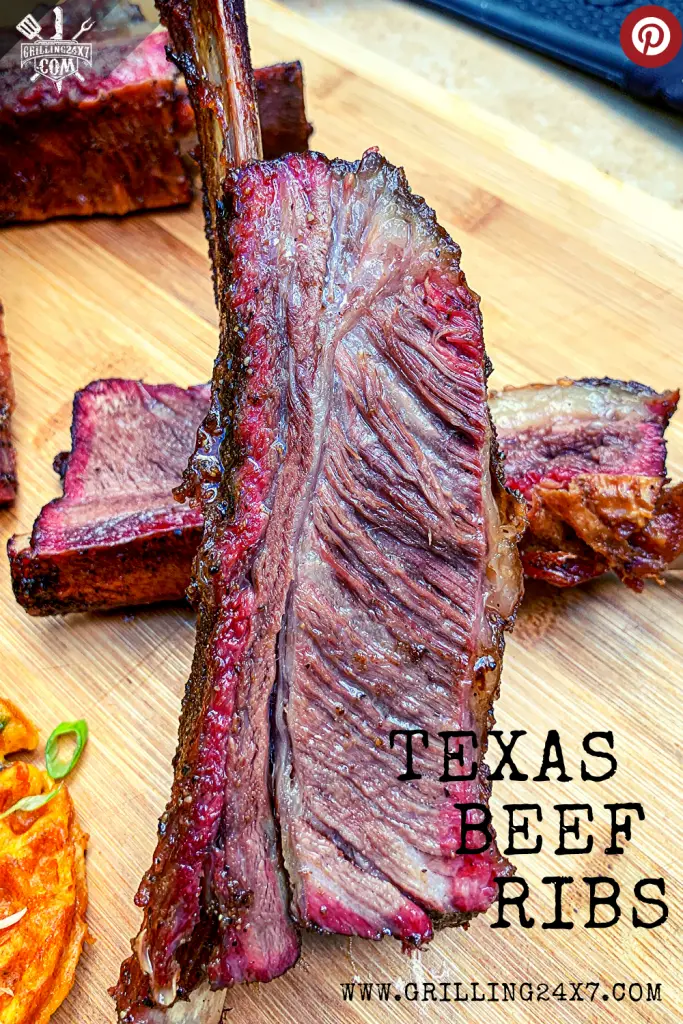
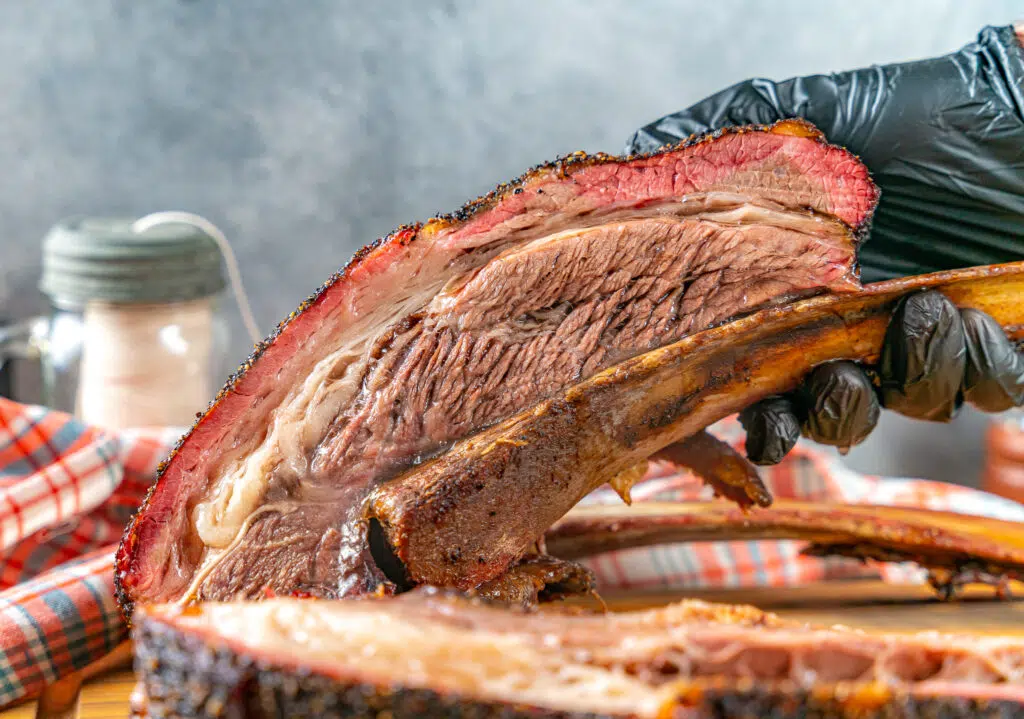
Texas Style Beef Plate Ribs made right in your backyard!
Over the summer I had the opportunity to taste some of the world's best bbq joints in Austin Texas. The beef plate ribs at Terry Blacks were especially amazing.
A single bone weighing in at just under a pound looked like something of prehistoric folklore. The meat was fatty but melted in your mouth barely needing to chew.
The post oak commonly used in central Texas gives the meat a subtle yet complex smoky flavor while preserving the natural flavor of the beef. The fact that the only seasoning used is salt & pepper blows my mind.
Since I live 1500 miles from Austin I had to figure out how to recreate these ribs using my pellet smoker at home.
To be honest the method for smoking beef ribs is very similar to smoked brisket. I jokingly refer to Beef Ribs as “Brisket on a Stick."
What you'll need for Pellet Grill Beef Ribs
- Meat: For this recipe, I used 8 lbs of beef plate ribs; specifically, two 4 bone racks of plate ribs. If you are looking for a recipe substitution or variation, you can also use pork ribs, chuck ribs, or dino ribs. The best way to find any of these cuts of meat is to stop by your local butcher shop.
- Seasoning: Get the best flavor with 8 tbsp of salt, pepper, and garlic from Spiceology.
- For Rub/Cooking: 4 tbsp of olive oil.
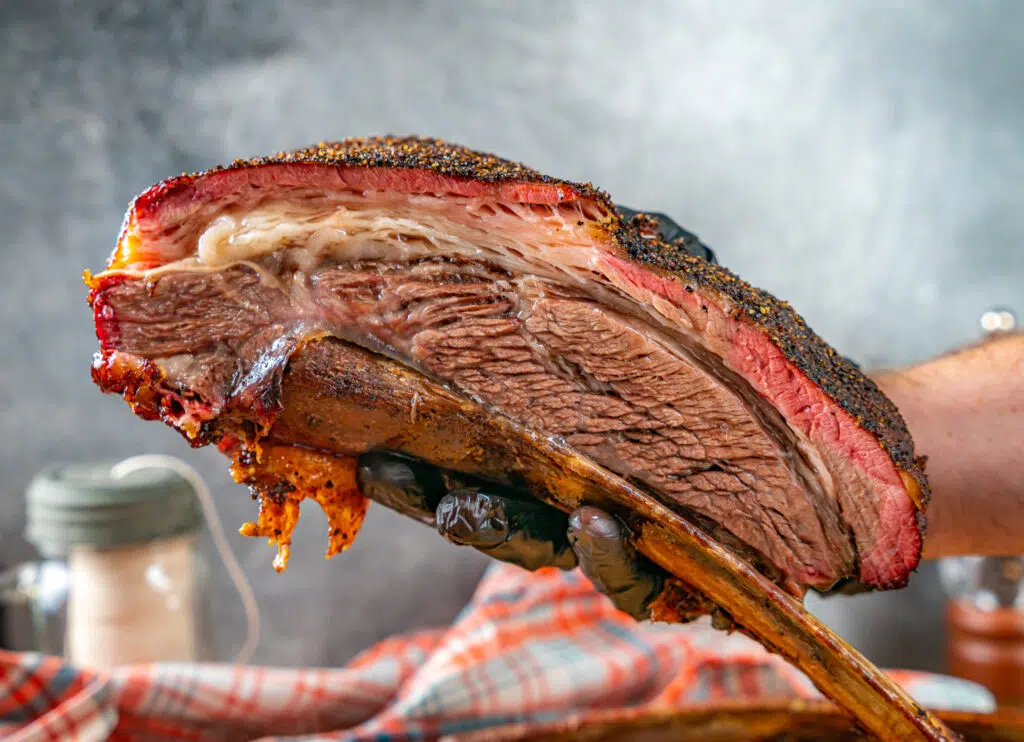
Equipment needed for Texas Beef Ribs
Smoker: It doesn't matter what type of smoker you are using, just pull it out and get started! For this recipe, I used a pellet smoker with a blend of wood chips or wood chunks.
Sharp Knife: Taking the skin off or slicing up the ribs? Make your life easy and use a quality sharp knife.
Cutting Board: When it comes time to slice up these juicy ribs, place ribs on a sturdy and quality cutting board.
Paper Towel: Whether you are dabbing meat or cleaning up a mess, paper towels come in handy when you are cooking!
Optional Seasonings for a DIY Beef Rub: If you are looking to make your own rub, consider using some of my favorite seasonings like a mix of kosher salt, garlic powder, chili powder, brown sugar, coarse black pepper, onion powder, and cayenne pepper.
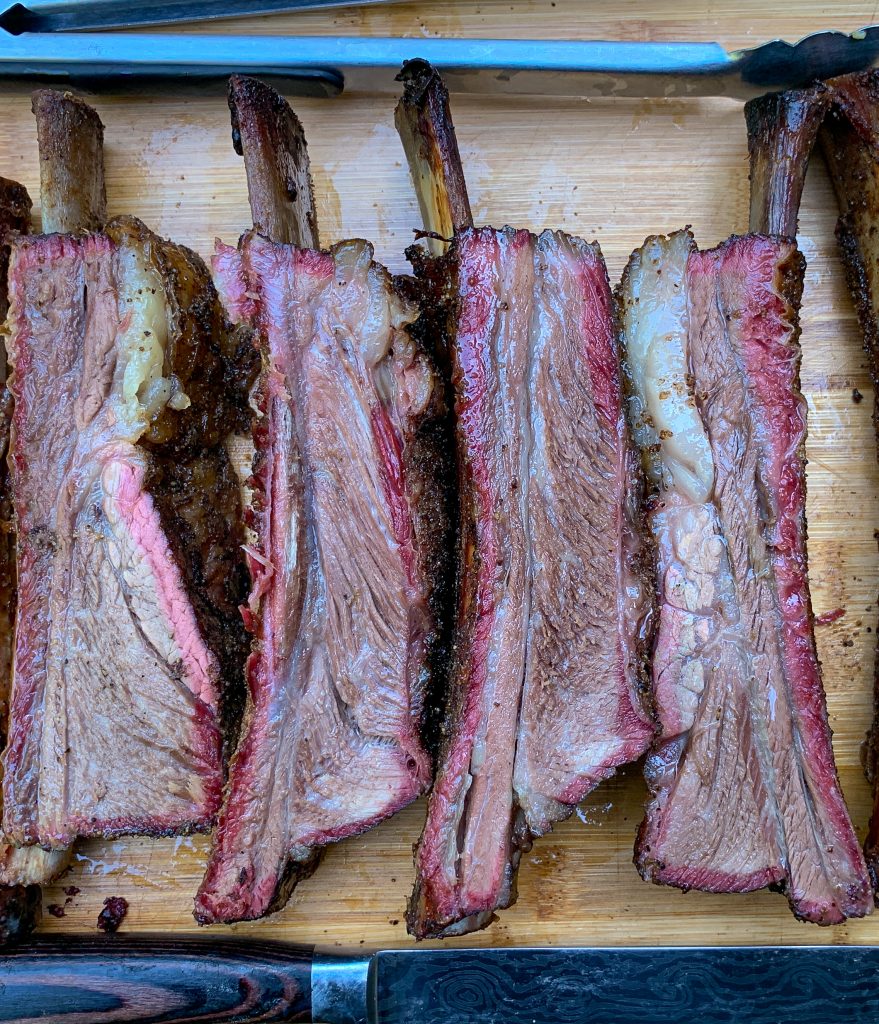
How to make Beef Ribs on Pellet Grill
Print Recipe- Preheat the smoker. Pre-heat your pellet smoker to 250 Degrees Fahrenheit.
- Remove skin. If you flip your ribs over to look at the bone side, you will find a layer of skin on top of the bone also known as silver skin, connective tissue, or tough silverskin. Before you get started, you are going to want to remove the skin from the ribs.
- Rub-down the meat. Pour two tablespoons of olive oil on each rack of ribs and rub into the meat on all sides
- Season the ribs. Season the ribs on all sides using the salt, pepper, and garlic seasoning from Spiceology.
- Start smoking. Set ribs in the smoker and cook for 3 hours before checking for color. Place probe in between the thickest part of the ribs.
- Continue smoking. Continue cooking until you reach an internal temperature of around 170 degrees F.
- Wrap the meat. Wrap ribs tightly with two layers of peach or pink butcher paper. Replace probe back into the ribs
- Continue smoking. Continue cooking until you reach a temperature of 205 degrees F. (about 2 hours) unwrap ribs and poke with a toothpick or probe to check fr doneness. Meat should be tender like butter. If meat is still tough continue to cook until tender.
- Leave wrapped and let rest. Once the meat is tender leave ribs wrapped and rest until the temperature lowers to around 160-170 degrees (about 1 hour).
- Enjoy! Once the meat has rested, slice, serve, and enjoy!
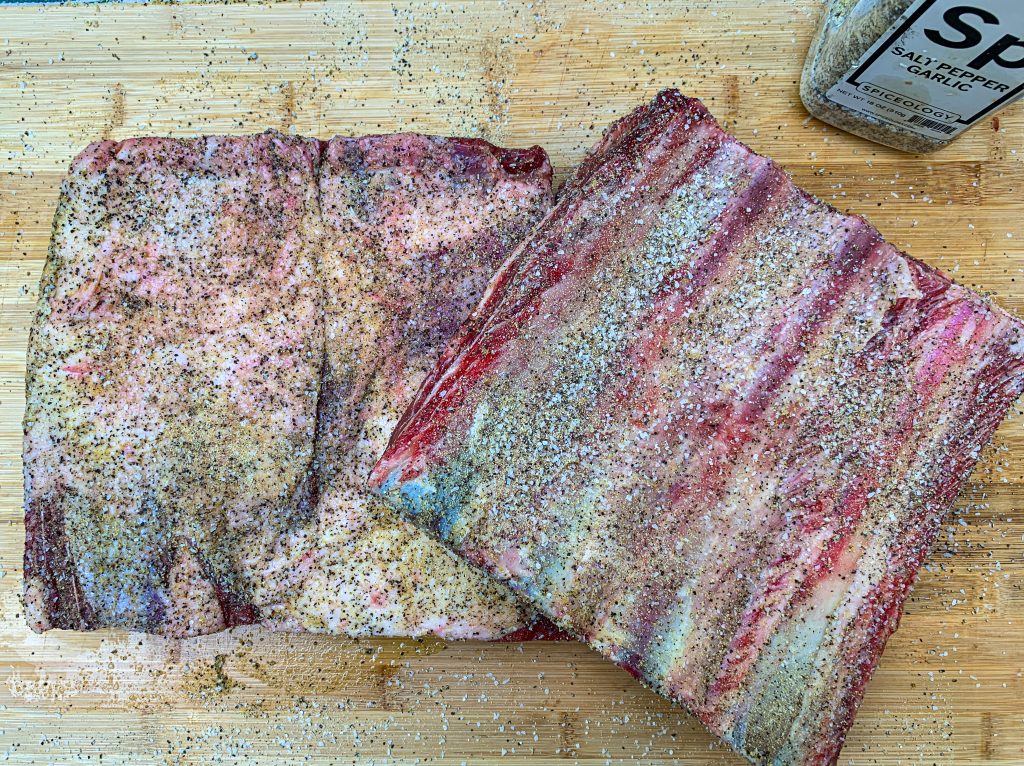
How to Season Beef Plate Ribs?
Seasoning Texas Beef Ribs is quite simple. I use a spice blend from Spiceology that contains just 3 ingredients: Kosher salt, pepper, and garlic.
If you’re feeling adventurous I would recommend a pinch of granulated onion but other than that let’s keep things simple.
Before seasoning, I like to rub the ribs down with a few tablespoons of oil just to help the seasoning stick to the meat.
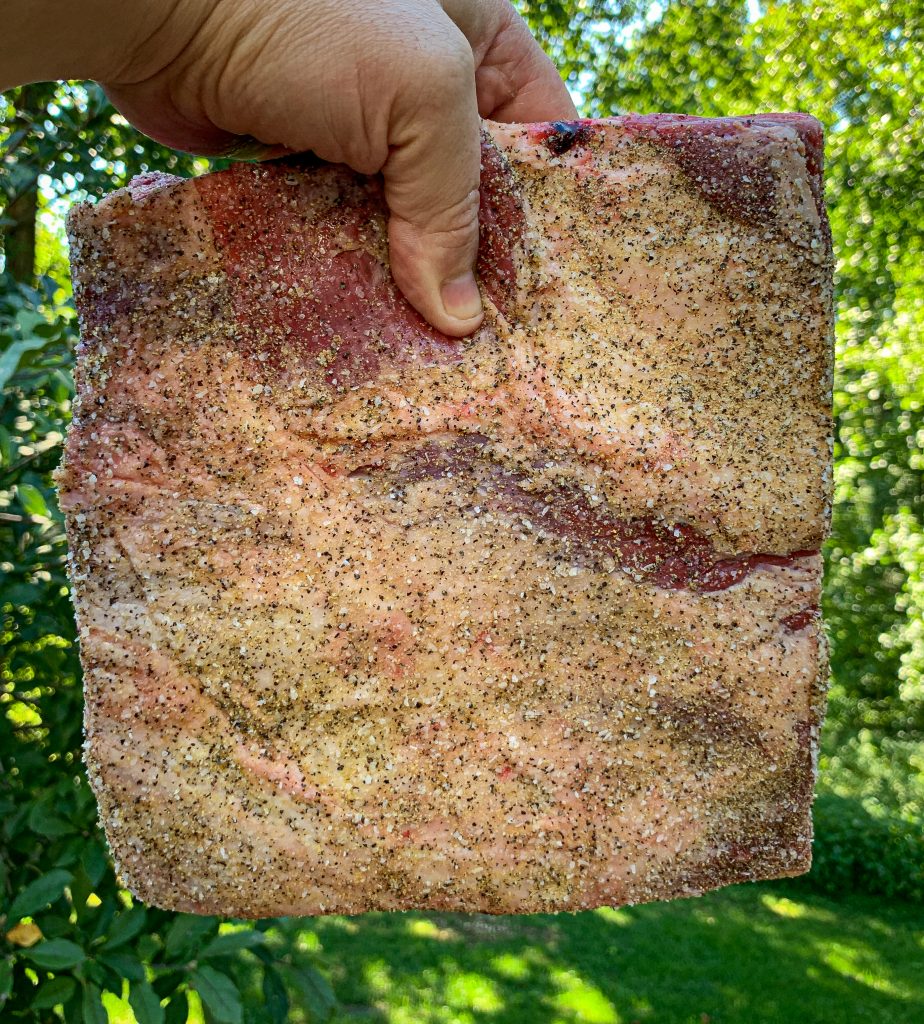
Don’t be shy with the seasoning, beef ribs can handle a good amount of salt so make sure you hit both fronts, back, and don’t forget the sides.
Just like a steak, I like my beef plate ribs to be as close to room temperature as possible before going on the pit.
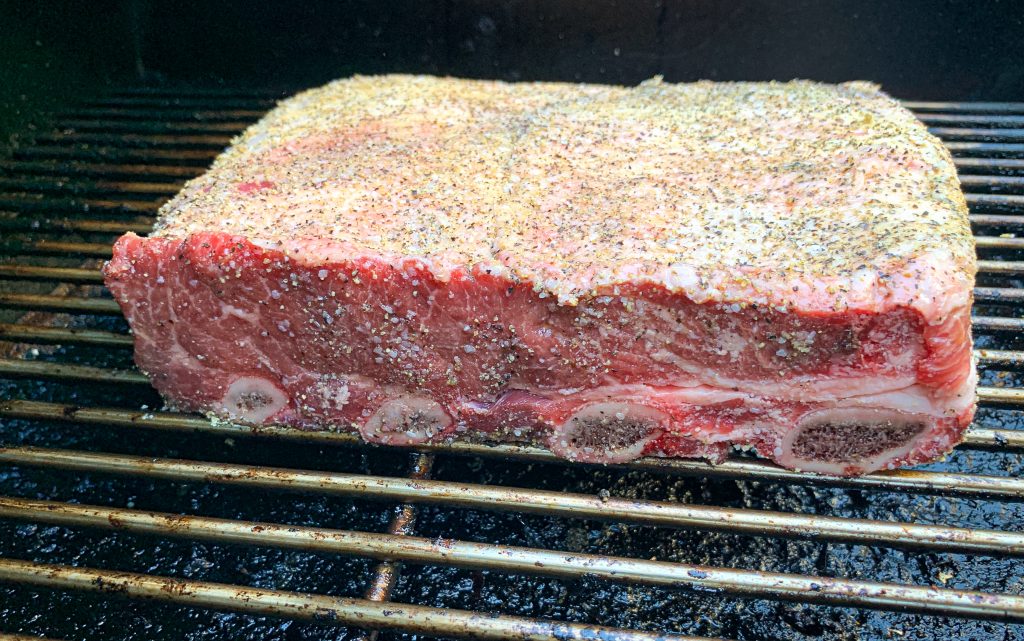
Speaking of the pit, I find that smoking at about 250 degrees F is my preferred temperature to give the meat time to absorb the perfect amount of smoke.
You could go as low as 225 degrees if you really want to take it slow or as high as 275 if you’re impatient.
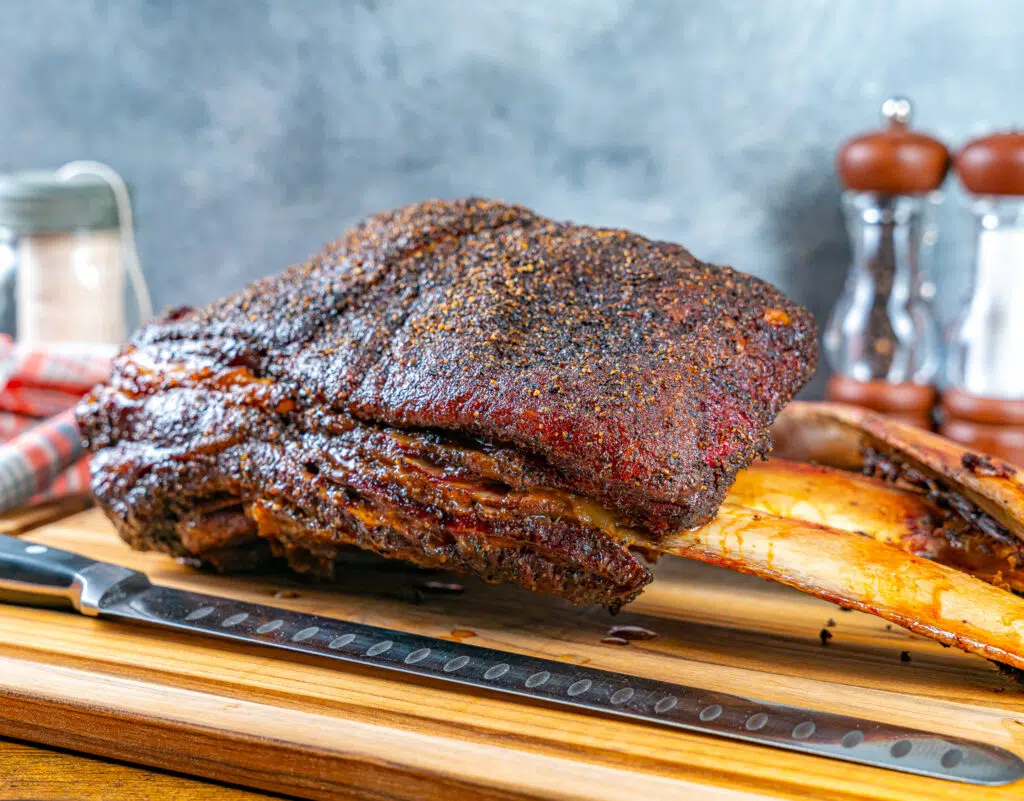
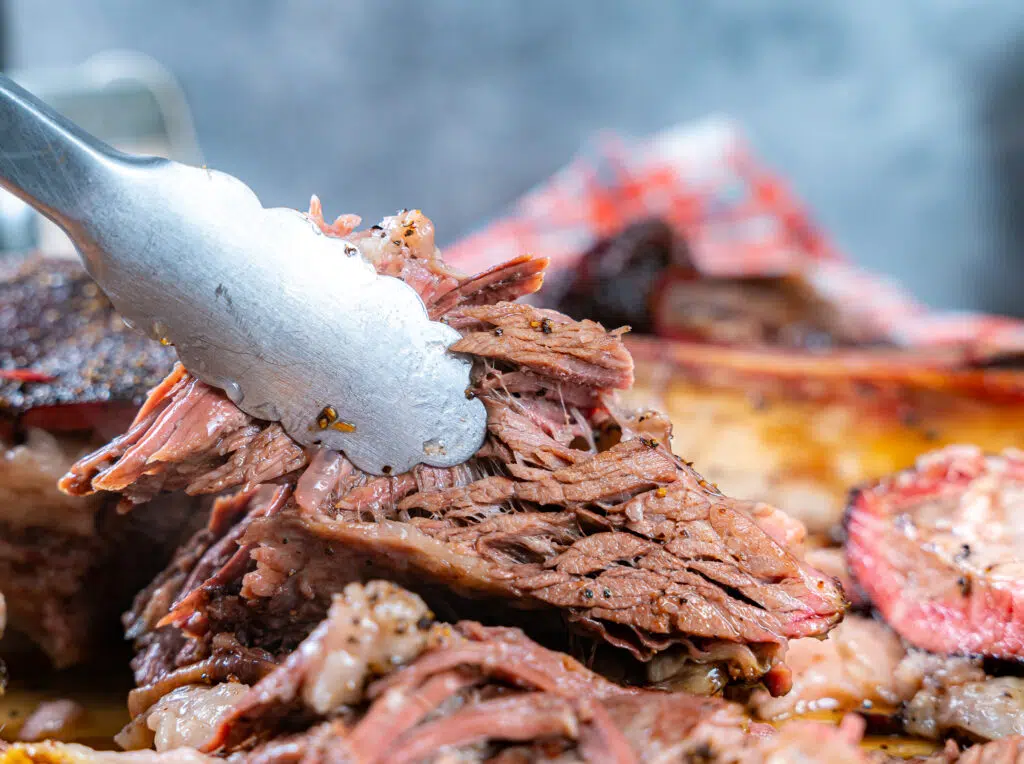
Pellet Grill Beef Ribs ... Set it and forget it ... almost!
Part of the advantage of pellet grills (especially the Rec Tec 700) is the precise temperature control.
Once your pit has reached temperature place the ribs on, place the probe in between the bones aiming for the thickness part of the rack. Then walk away for about 3 hrs. As they say “if you’re lookin’ it ain’t cookin’ “
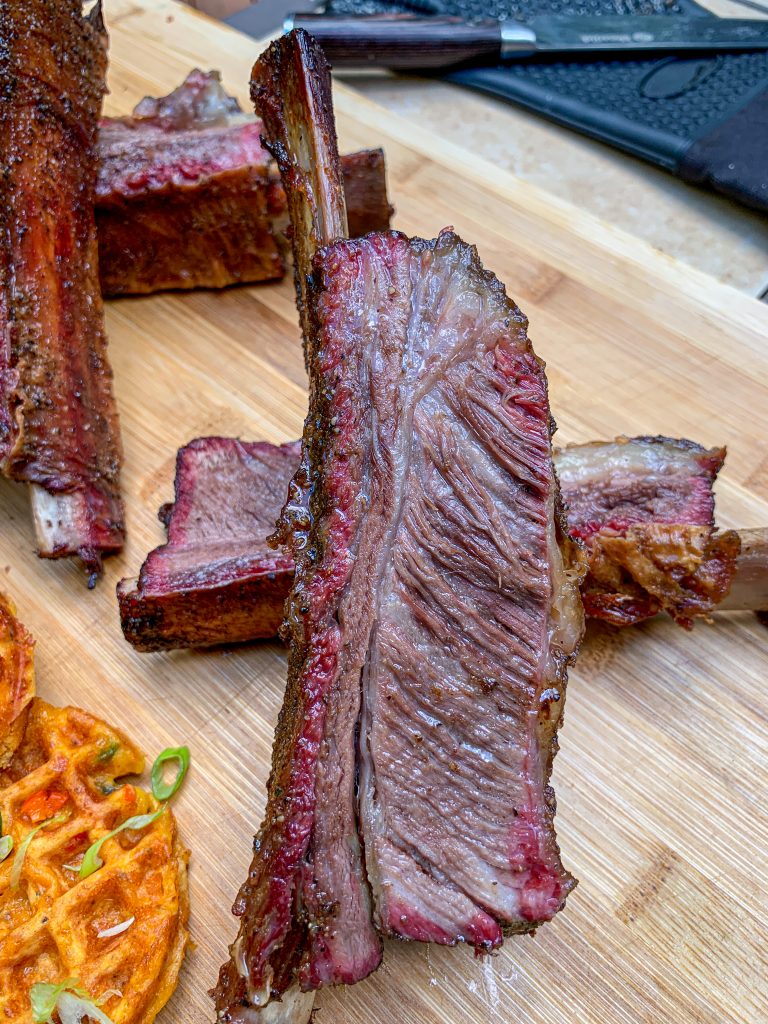
After about 3 hours the meat should start to tighten up on the bone. The end rib always seems to pull away a bit more and may even separate completely by the end of the cook.
Don’t worry, it will be just as delicious as the two presentation ribs in the center. After taking a quick peek at the 3 hr mark if all is well and you’re happy with the color you can shut the lid and go for about 2 more hours before checking.
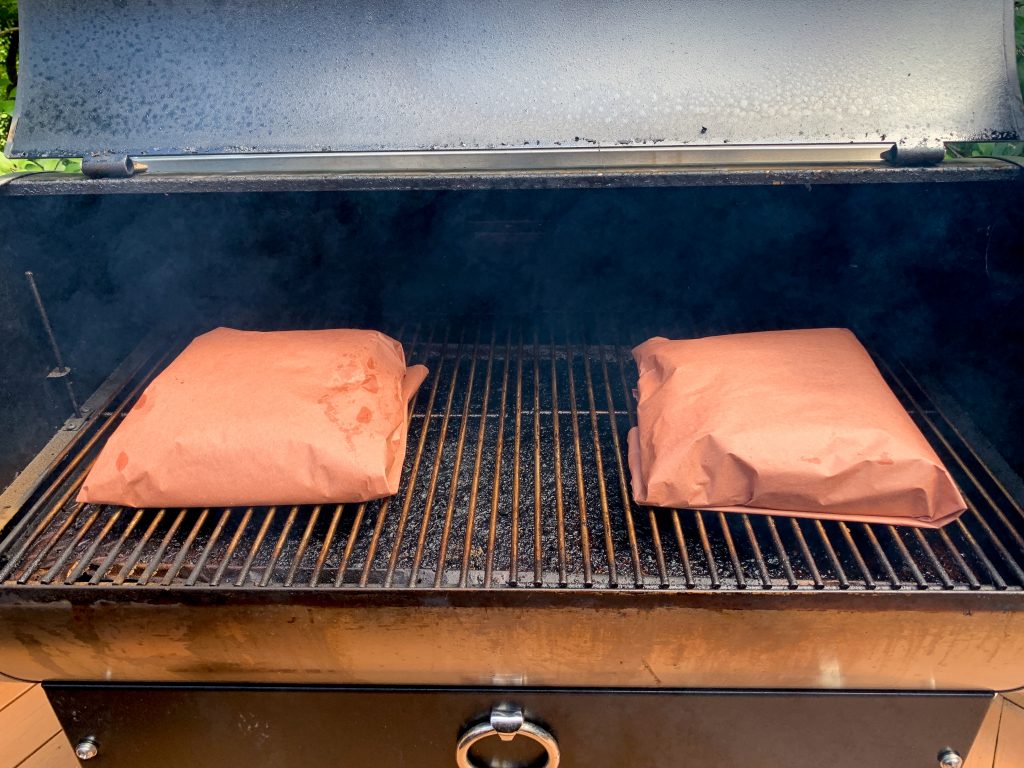
Should I mop these Texas Style Beef Ribs?
I didn’t mop or spray these ribs but if you feel they’re looking dry a spray bottle with some Worcestershire and diluted beef broth is really all you need.
Once the rack has reached an internal temperature of around 170 it may stall similar to brisket as it begins to break down the connective muscle fibers in the meat.
That’s when I like to wrap the beef ribs in peach food-grade butcher paper.
Ever since visiting Texas and using butcher paper instead of aluminum foil I’ve never looked back.
The butcher paper seals in the moisture while simultaneously letting the meat breathe and not steam. The final product is much more tender and juicy.
I do recommend a double layer of butcher paper and no parchment paper won’t work. The butcher paper is much stronger and won’t tear on the corners.
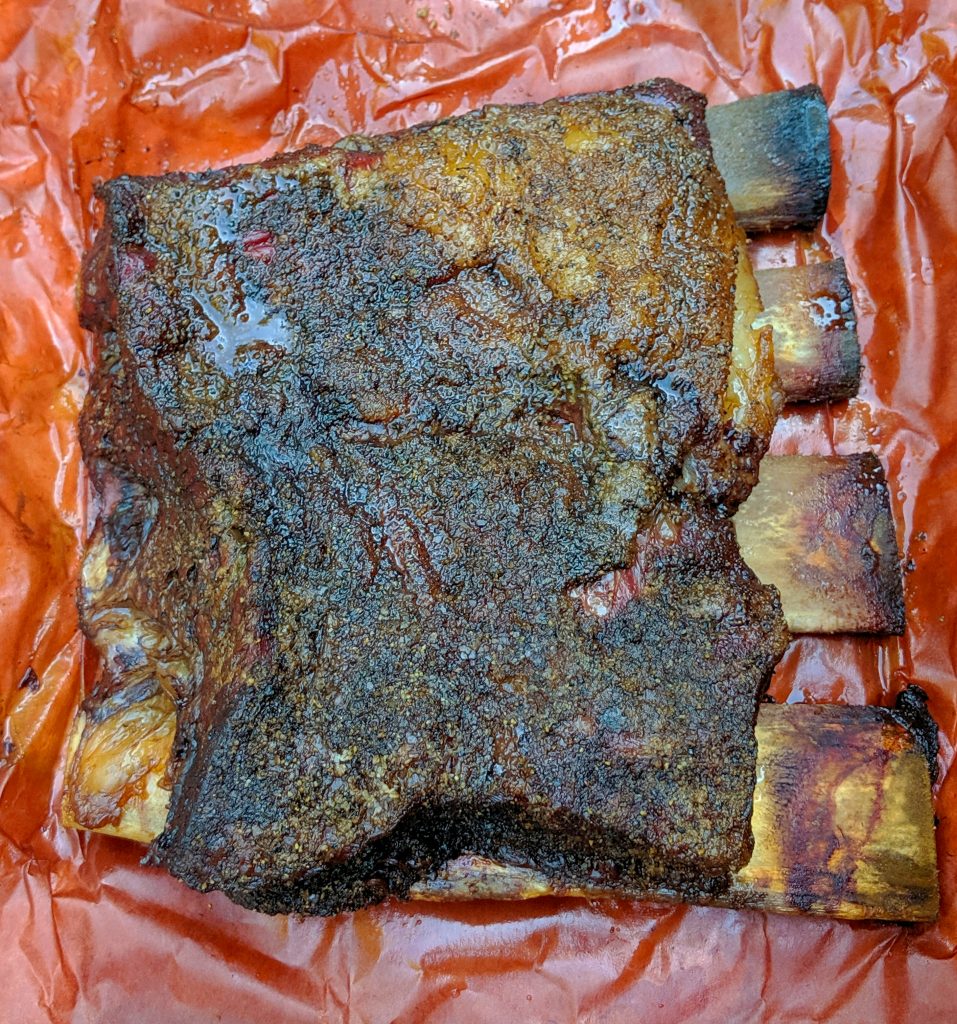
Should I use foil on these Texas Beef Ribs?
Once the ribs are double wrapped in butcher paper you can plunge the probe back into the rack aiming for the center as best you can.
Place the ribs back on the smoker and continue cooking until you hit an internal temperature of about 205 degrees F. At this point, you need to poke the ribs with a toothpick or probe to test for tenderness.
The probe should go into the meat without any tension almost like butter. If it fights back or requires effort to puncture then continue cooking.
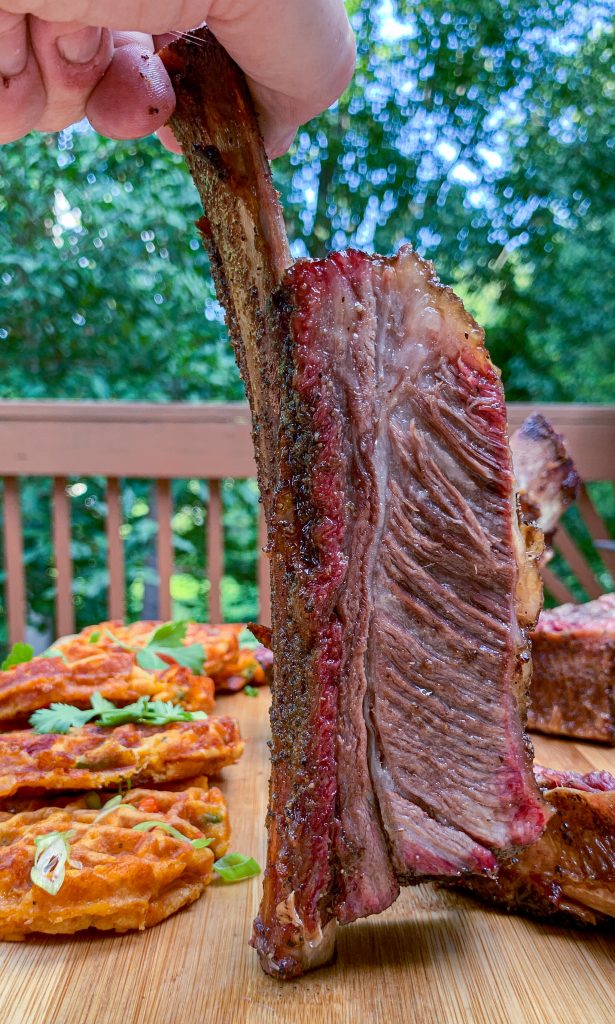
Patience ... Let the Texas Style Beef Ribs rest!
Now I know you’ve got a beautiful rack of beef ribs that are tender smoky and delicious but we’re not ready to eat just yet.
Resting beef ribs is paramount much like brisket due to the high-fat content and needs time to reabsorb the juices. As a rule, I like the meat to rest for at least an hour.
I keep the probe thermometer in the meat as it rests and look for the temperature to drop to around 160-170 degrees before slicing.
The ribs should not completely fall off the bone but should be so tender that they need to be treated gingerly to keep them together.
Using a sharp sliver knife cut in between the bones revealing that beautiful smoke ring and juicy tender interior.
All of your patience will be rewarded with that first bite. Whether you are a true Texan or an east coaster like me these Beef Plate Ribs will be legit.
Do you See those Crispy Jalapeno Cheddar Cornbread Chaffles??? Click Here for the Recipe!!!
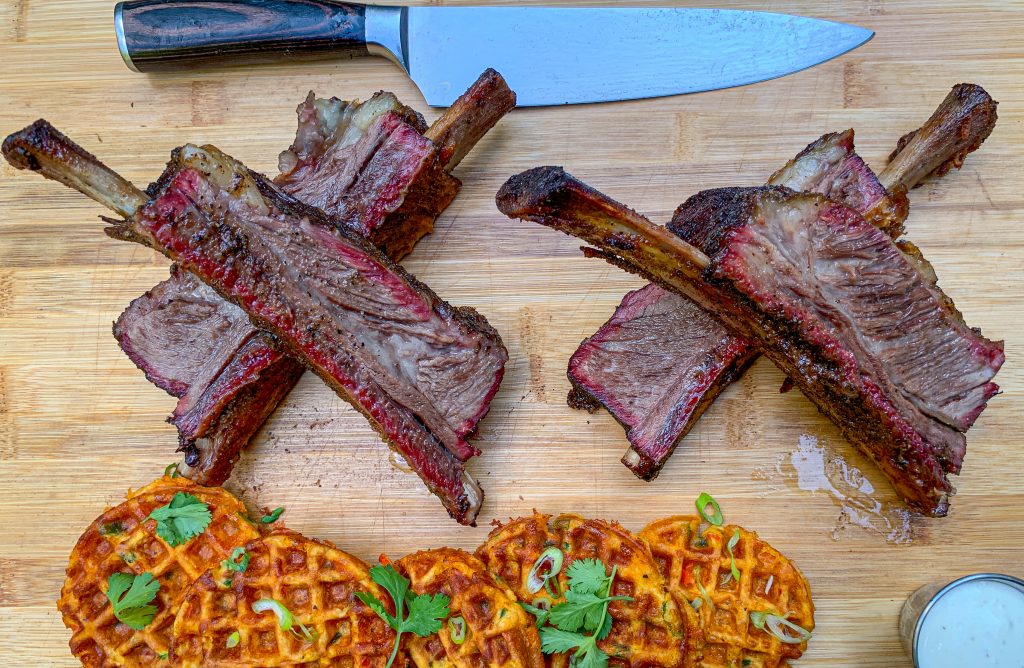
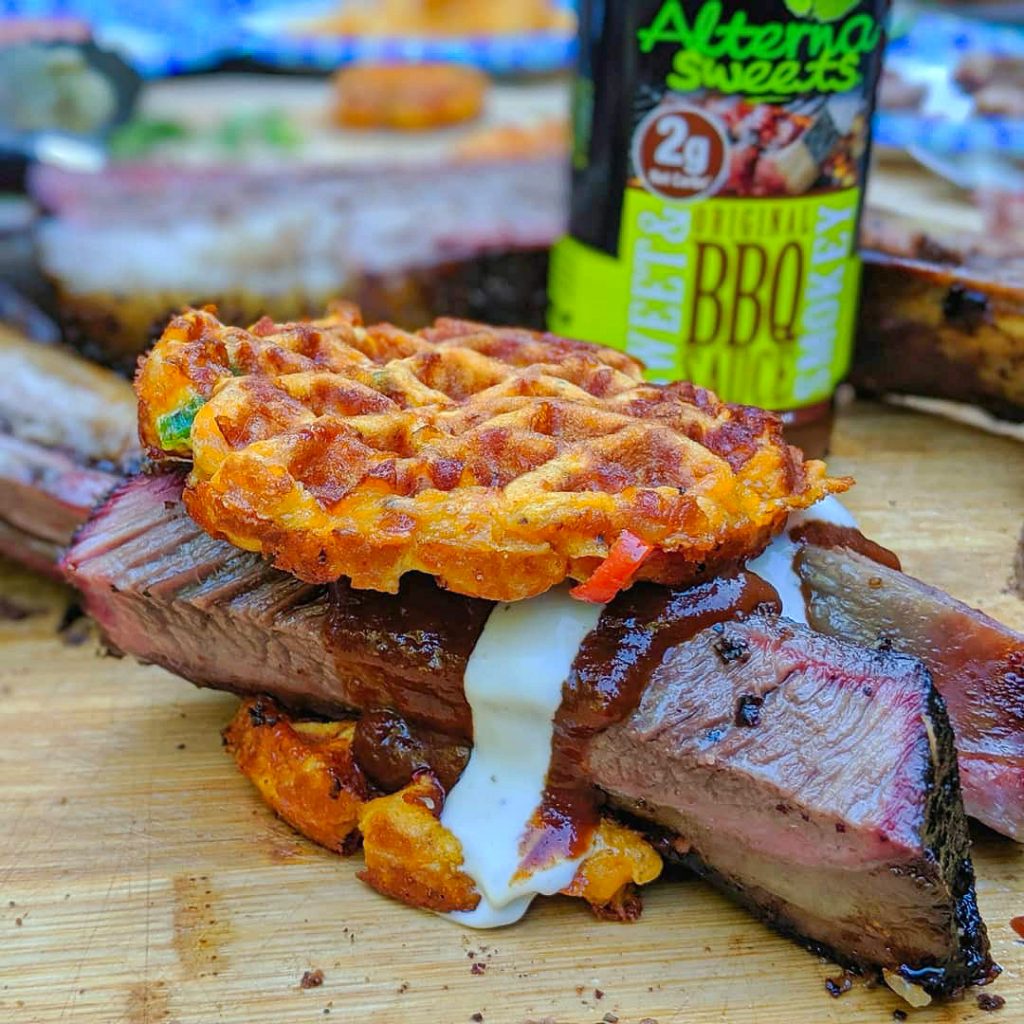
Beef Ribs on Pellet Grill FAQs
In Texas, I’m sure you can find beautiful racks of Beef Ribs at your local H-E-B (local grocery chain) but here in Maryland, the only beef ribs I’ve ever found are either cross-cut short ribs or beef back bibs.
Cross-cut short ribs are what are commonly served at Korean bbq restaurants, very tasty but much less impressive.
Beef Back Ribs are actually cut higher up on the spine and cut away from the Prime Rib. Butchers don’t leave much meat on beef back ribs because they would rather sell that meat as the much pricier prime rib.
When shopping for beef ribs ask your butcher for “beef plate ribs” or “Texas-style beef ribs” ideally they will trim any excess fat off the back along with removing the membrane similar to how you would treat a pork spare rib.
The bones will range anywhere from 8-12 inches in length. If all you can find are single bone short ribs you can still follow this recipe but will need to adjust the time according to the size of the short ribs.
Beef Back Ribs are found further down on the rack and tend to be smaller with less meat. Plate ribs come from the top of the rack and are normally cut from the first 3-4 bones.
Yes, Beef ribs will stall very similar to how a brisket would. The cooking process is the same and I recommend wrapping the beef ribs once you reach the stall around 170 degrees F.
Texas has always been known for their beef bbq over pork and as they say everything is bigger in Texas. That is why Texas Ribs are associated with large beef ribs.
More like this Beef Ribs Pellet Grill recipe
- Smoked Beef Brisket: Tips and Tricks
- Pellet Smoker Recipe: Reverse Sear Tri-Tip w/ Smoked Tomato Salsa
- Smoked Corned Beef: Pellet Grill Recipe
- Smoked Eye Round w/ Beef Au Jus
- Reverse Sear Tomahawk Ribeye w/ Chanterelle Mushroom Cream Sauce
Texas Beef Ribs
Ingredients
- 8 lbs Beef Plate Ribs Two 4 bone racks of Plate Ribs
- 8 tbsp Salt, Pepper, Garlic Spiceology
- 4 tbsp Olive Oil
Instructions
- Pre heat Pellet smoker to 250 Degrees F.
- pour two tbsp of olive oil on each rack of ribs and rub into meat on all sides
- season the ribs on all sides using the salt, pepper, garlic seasoning
- set ribs in the smoker and cook for 3 hours befor checking for color. Place probe in between the thickest part of the ribs.
- continue cooking until you reach an internal tempurature around 170 degrees F.
- Wrap ribs tightly with two layers of Peach Butcher Paper. Replace probe back into the ribs
- Continue Cooking until you reach a tenperature of 205 degrees F. (about 2 hours) unwrap ribs and poke with toothpick or the probe to check fr doneness. Meat should be tender like butter. if meat is still tough continue to cook until tender
- once meat is tender leave ribs wrapped and rest until temperature lowers to around 160-170 degrees (about 1 hour) slice and serve.

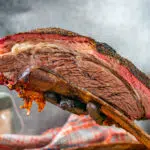
Blossom Smith
We don’t have a regular smoker. We have a large round Weber and a really big rectangular regular grill. Can we use either of those instead big chunks?
Culinary Lion
You can smoke the beef ribs using indirect heat. Weber Kettle is great just build your coals on one side and keep the ribs opposite the fire. regulate the dampers and maintain a steady fire